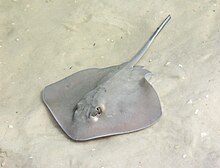Stingray
$200.00
Stingray (Dasyatis pastinaca)
The common stingray can reach a maximum width of 1.4 meters (4.6 feet) and a length of 2.5 meters (8.2 feet), although a typical width is around 45 centimeters (18 inches). Its flattened, diamond-shaped pectoral fin disc is slightly wider than it is long, with narrowly rounded outer corners. The leading edges of the disc are nearly straight, converging on a pointed, slightly protruding snout, while the trailing edges are convex. The eyes are smaller than the spiracles, which are positioned closely behind them. The stingray has 28–38 rows of upper teeth and 28–43 rows of lower teeth, all small and blunt, forming flattened surfaces, along with five papillae (nipple-like structures) on the floor of the mouth.
The tail is slender and whip-like, approximately half the length of the disc. It features a stinging spine with serrations, up to 35 centimeters (14 inches) long, located about one-third of the way along the tail and connected to a venom gland. A second or even third spine may also be present, as these spines are replaced regularly, with new ones growing before the old ones are shed. The tail behind the spine has a low cutaneous fold on top and a short, deep fold underneath. The body and tail are mostly smooth, with some dermal denticles along the leading edge of the disc; older stingrays may develop a row of bony knobs along their midline. Their coloration typically ranges from solid gray, brown, reddish, or olive-green on top to whitish below, with dark margins on the fins. Young stingrays may have white spots.
The largest recorded common stingray was discovered in 2016 in the Izmir province of Turkey during a trolling study. Its fin width measured 2.21 meters (7.3 feet), although its length was undetermined due to the removal of its tail.
